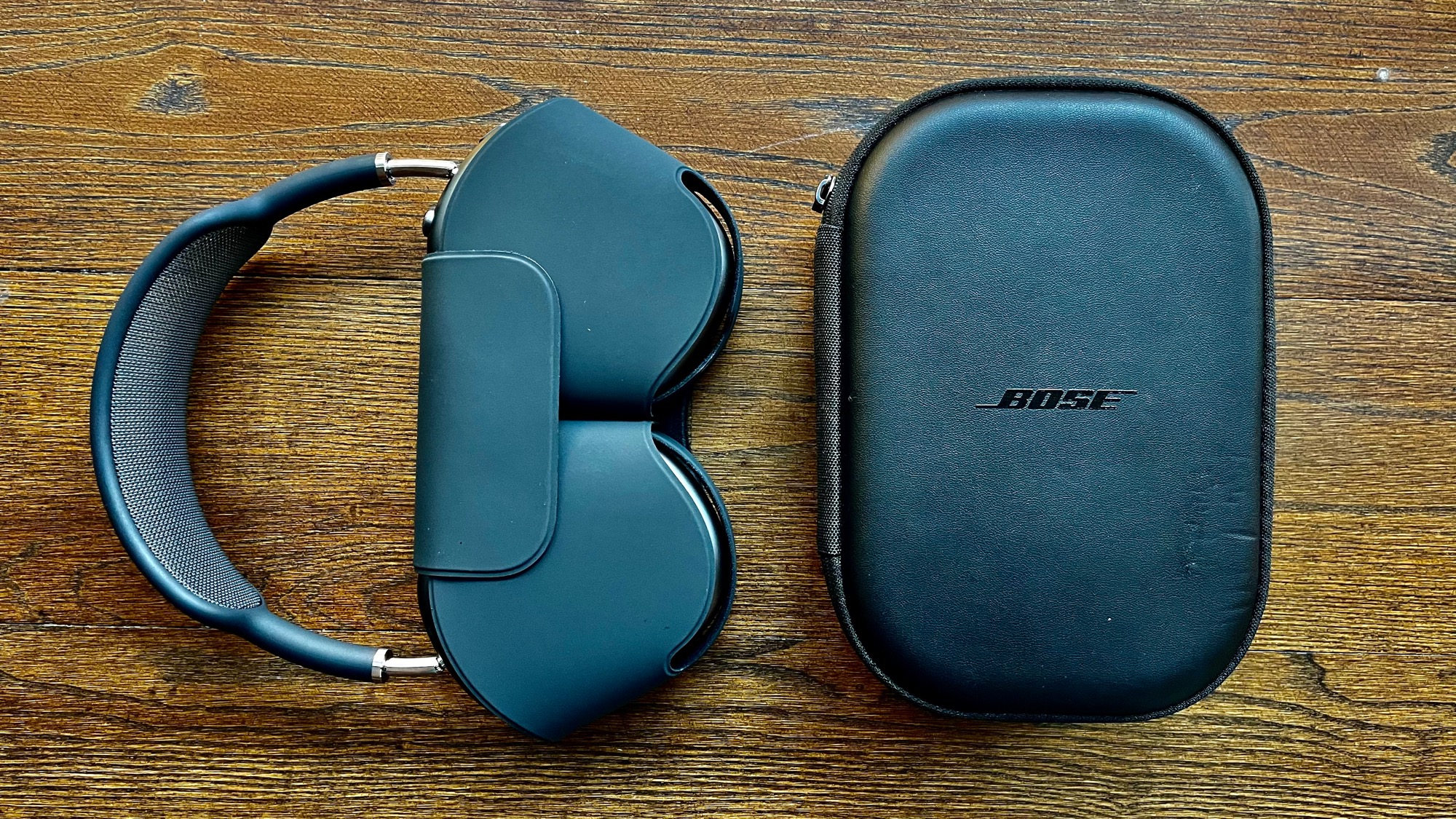By John Gruber

Stop political robocalls & texts with Nomorobo!
24% off with code DARINGFIREBALL24.
Heavy Is the Head That Wears the AirPods Max
Thursday, 10 December 2020
What a fascinating product Apple’s new AirPods Max are. At $550, they are indisputably expensive, and at 385 grams, they are undeniably heavy.
They’re also, indisputably, very nice.
Apple sent me a pair to review (Space Gray, natch) yesterday, and I’m really not sure what to make of them. Here’s what I can tell you after a day and a half.
AirPods Max are quite heavy: 385 grams. My Bose QuietComfort 35 II wireless headphones weigh 235 grams. Other noise-canceling wireless headphones are even lighter. You can definitely feel the difference in weight. The AirPods Max headband does seem to distribute the weight as comfortably as it can, but the weight is all in the ear cups, and heavy ear cups are, well, heavy. When you remain motionless, you can forget they’re there. But when you move around, the AirPods Max have inertia. They move a bit when you shake your head side-to-side, and they move a lot when you nod your head up and down. Look down at your feet and look back up and you’re instantly reminded, Oh yeah, I’ve got heavy cans on my ears. You feel a bit bobble-headed with them on. The heaviness of the AirPods Max doesn’t make them uncomfortable, per se, but it definitely feels like they’re intended for stationary use. Their lack of water resistance aside, the weight keeps them from being the sort of headphones you’d want to use while exercising any more vigorously than a brisk walk.
As mechanical devices, the AirPods Max are remarkable. Sturdy, solid, pleasant to touch. Every other pair of over-the-ear headphones I’ve ever used feels a bit cheap in comparison, because my over-the-ear headphones have all been constructed mostly of plastic. Plastic ear cups, plastic headband. Often, very nice plastic, but plastic. AirPods Max are very much metal. Aluminum ear cups, and a stainless steel headband. They are very sturdy, and very nice to the touch. It’s like when Apple started making laptops out of unibody aluminum — the plastic ones we had long accepted as the norm suddenly seemed cheapjack in comparison. In some ways, AirPods Max feel quite a bit like a premium Aeron-style modern desk chair — the mesh canopy atop the headband, the telescoping steel stems, the general sturdiness.
The foam ear pads are removable, and they’re just a delight to pop off and pop back on. They connect magnetically, and just jump into place.
I let my son try them out, and when he clicked the button to toggle the noise control mode, he said “Oh, that’s a nice button. It has a good click.”
“Is it a $550 click?” I asked.
He clicked it a few more times.
“It’s not not a $550 click.”
When it comes to audio quality, AirPods Max might not not sound like a $550 set of headphones, too. This is the part of the review where I’m tempted to preface everything with “Look, I’m not an audiophile…”, but screw that. I’m not an audio expert, but I do know what I like, and I love the way these headphones sound. They make music sound rich and make movies sound very real. I also love that there are no fiddly EQ settings. You set the noise mode (Noise Cancellation, Transparency, or none), you set the volume, and that’s it. The AirPods Max figure out the rest. That’s exactly how I want headphones (and speakers) to be. Just make it sound great.
Watching a movie with spatial audio is an experience. According to Apple, spatial audio kicks in when you listen to movies or other video encoded with 5.1 or 7.1 surround sound, or Dolby Atmos. It’s uncanny and very clever when wearing AirPods Pro earbuds; with AirPods Max, it’s absolutely immersive, like something from an attraction at Disney World. Watching an action movie, it’s downright visceral. Get into a movie or show with compatible audio (Disney+’s The Mandalorian is good — it’s a fun show, period, and has great sound design) and you will forget you’re wearing headphones. It really does sound like you’re in a room equipped with theater-quality surround sound speakers. Spatial audio is rich and immersive and crystal clear. Effects and dialog sound like they’re coming from fixed spots around you, not just with direction but with depth. It’s less like wearing headphones and more like wearing an augmented reality audio headset.
But: spatial audio only works (for now at least) when the video source is an iPhone or iPad. The AirPods (Pro or Max) know when your head is moving, but the source device needs to be location-aware too, and for now, that means iPhones and iPads only. It’d be nice if it worked with MacBooks too — you shouldn’t pay an audio experience penalty for watching a movie on a MacBook rather than an iPad. But the device that’s just begging for spatial audio support is Apple TV. If you’ve got a small apartment, thin walls, or someone sleeping next to you, it’s natural to want to use AirPods Max to watch a movie with the full spatial audio experience, as loud as you want, on the biggest screen in your house, without disturbing anyone. But you can’t. You can only get this big room-sized audio experience with the small visual experience of an iPad or iPhone screen.
I get it. If spatial audio needs hardware support on the playback device and the Apple TV 4K doesn’t have it, then it doesn’t have it. But Apple TV 4K is $180! It’s crazy that Apple sells a premium movie-watching set-top box and very premium movie-listening wireless headphones and they don’t work together for a premium spatial audio movie-listening experience.
When am I going to watch a blockbuster movie on an iPad instead of my TV? When I’m traveling, of course. For me, personally, without Apple TV support, that’s the only time I’d ever use AirPods Max to watch video.
I almost never wear headphones while working at my desk, and for recording podcasts, I want wired headphones, to eliminate all latency. You can use AirPods Max as wired headphones with a Lightning to 3.5 mm headphone jack cable, but that’s certainly not what they’re meant for. Buying a pair of AirPods Max to use solely as wired headphones (especially purely to make voice calls) would be like buying an airplane to drive around on the ground.1
My main point of comparison is my aforementioned Bose QuietComfort 35 II wireless headphones. I’ve had them for about two years, maybe three, and use them almost exclusively while on airplanes. Well, used them. I haven’t been anywhere, let alone an airplane, since early March. And I actually took two trips last winter with just my then-new AirPods Pro, rather than the QuietComforts. There’s only so much space in a carry-on bag.
Once you get used to noise-canceling headphones on an airplane, there’s no going back. When you’re listening to music or podcasts or a movie, it’s almost essential to cancel out the noise of the plane itself. And even when I’m just reading or writing on a plane, I love wearing noise canceling headphones playing nothing, just to block the noise.
AirPods Pro noise cancellation is very good, for earbuds, but it’s nowhere near as effective as with over-the-ear headphones — if only for the obvious reason that over-the-ear headphones help block noise even when they’re powered off, because they double as physical ear muffs in addition to the active noise cancellation. Swapping the superior-sounding Bose QuietComforts for AirPods Pro (which I’d be traveling with regardless) is a win, space-wise, in a laptop bag. The trade-off in audio quality for a vast reduction in volume and weight felt like a close call overall, though.
AirPods Max, as travel headphones, go the other way. They’re heavier and twice the price of the QuietComforts ($550 vs. $270), but they sound so much better. And while the AirPods Max headphones themselves seem, I repeat, quite sturdy, the included “Smart Case” is less of a case than it is a pouch. The fact that it’s not a hard case helps narrow the weight gap — the AirPods Max in the Smart Case weigh 520 grams; the Bose QC35’s in their case weigh 410 grams — but it makes them something you might need to be a little careful with when packing, and because they don’t fold up (the ear cups do rotate to fold flat, though), they take up a bit more space:
What makes the AirPods Max Smart Case “smart”? It includes magnets that let the AirPods Max know when they’re inside, which puts them into a hibernation state that prolongs battery life. Just how much difference that makes, battery-life wise, compared to just leaving them, unused, out of the case, I can’t say. I’ve only had them a day and I’ve spent a lot of that time wearing them. This, in turn, points to the fact that unlike just about any other wireless over-the-ear headphones, AirPods Max do not have an on/off switch. I’m not saying they should, but it’s very Apple-like that they don’t.
If I flew a lot more than I do (in non-pandemic times), especially longer flights, I’d order a pair of AirPods Max now. As it stands, I don’t know. Any movie with a soundtrack cool enough to blow me away with spatial audio is probably a movie I want to see on a big TV in my living room, not my iPad propped up on an airplane seat-back tray. But on the other hand, if I’m going to watch a movie on a plane, and I can’t make the screen bigger, maybe it’s worth it to make the audio as awesome as possible — to at least satisfy one of my senses.
Bottom Line: AirPods Max sound great and they’re very well-made, but their premium audio and build quality come at the expense of making them quite heavy, and, well, quite expensive. If you think any wireless headphones could be worth $550, these might be them. And Apple TV ought to support the spatial audio features, because if it did, these would be amazing living room headphones.
-
AirPods Max don’t look like they have a built-in microphone for voice calls, but they do, and it’s at least as good as the mic on regular AirPods. ↩︎

